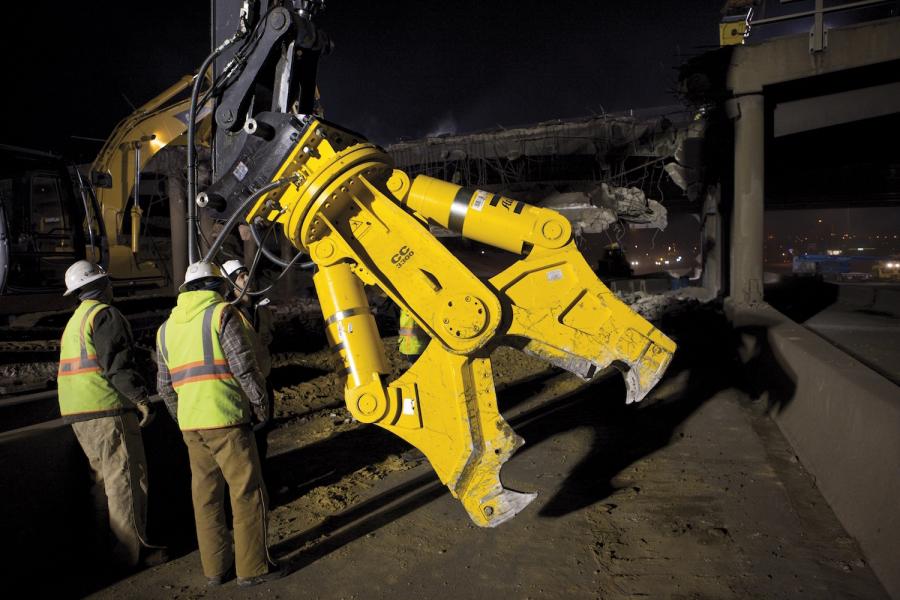The Atlas Copco Combi Cutter works to cut rebar and demolish concrete during a bridge project in Colorado.
Hydraulic attachments serve a dual purpose: They can be used in both demolition and deconstruction applications, from buildings and tunnels to bridges and roadways. Demolition requires breaking down materials, such as asphalt, concrete and rebar into small, transportable pieces that are taken to a landfill or sorting yard. Deconstruction, on the other hand, means dismantling and sorting materials for recycling or proper disposal. In both cases, whether you are disposing or recycling, contractors gain the advantage of greater productivity when they have the right tool for the job.
Break it Down
Regardless of whether material will be disposed or recycled and repurposed, it must be removed, and there are a wide variety of attachments that contractors can use to do this.
Breakers — ranging from 120 to 22,000 lbs. (54 to 9,979 kg.) — are the go-to choice for demolishing materials. These attachments provide the force to break up some of the toughest materials, which earned them their name. But when it comes to attachments and what they can do, breakers just scratch the surface.
Pulverizers crush and separate reinforced concrete from steel, which makes them ideal for demolishing or deconstructing cement columns in parking garages and building entrances. These attachments quickly eat through concrete and rebar with as much as 350 tons (317.5 t) of cutting force and 110 tons (100 t) of crushing force.
Pulverizer attachments cleanly separate rebar from concrete, so they're ideal for secondary demolition and sizing reinforced concrete materials.
Other attachments serve two purposes to help increase efficiency. For example, a cutter that can crush concrete and cut steel, such as rebar, at the same time helps boost productivity and reduces time spent on the job. The demolished materials are then easily sorted.
Cutters like these can often be equipped with a wide range of jaws. Universal, or U-Version, jaws, for example, are perfect for cutting general structural steels, separating steel from concrete and demolishing heavily reinforced concrete. Other jaws, such as the S-Version, are for cutting steel and demolishing steel materials with scissor-like cutting heads.
One example where cutter-crusher combo attachments have played an integral role in the success of a job was during a bridge project in Colorado. The Colorado Department of Transportation chose an Accelerated Bridge Construction, or ABC, approach to improve operations at Denver's Pecos Street and Interstate 70 interchange. Staker Parson Company had only four hours to demolish the old bridge and move a replacement bridge into place. In addition to the tight deadline, the existing bridge was still in good shape, which made it harder for crews to demolish.
The demolition crew used two Atlas Copco CC3300 Combi Cutters and four of the company's hydraulic breakers to demolish the bridge. The Combi Cutters and breakers started in the middle of the bridge and worked outward. As the breakers struck rebar, the cutters came over, sheared through the bars and moved to the next spot. Despite having only four hours to complete the job, the crew finished by deadline with minimal cleanup — and the new bridge was opened to traffic on schedule.
In addition to the accuracy of attachments like the Combi Cutters, drum cutters are a great option for removing precise layers of asphalt, concrete or frozen ground in tunnels and trenches or on roadways for small repairs. They are equipped with numerous picks, or teeth, that spin around a cutting drum as fast as 110 rpm to evenly and accurately profile the material, leaving a uniform surface. This attachment can save contractors in material costs since they don't need to remove all of the materials, but rather just the damaged or worn surface.
Sort it Out
Once material is removed or demolished, operators can quickly sort it using grapples and magnets. Hydraulic magnet attachments feature onboard, hydraulically-driven generators that rapidly energize the magnet to attract as much as 16,535 lbs. (7,500 kg) of ferrous metals, such as iron and steel. This allows contractors to easily and quickly pull rebar and metal from rubble.
In addition to magnets for sorting, grapples are ideal for lifting and placing rubble into waiting dump trucks or to sort recyclable building materials, such as concrete, steel and rebar. Grapples make sorting easier with their synchronized jaws and can handle a mouthful. For instance, Atlas Copco's MG 5000, the company's largest grapple, clutches 2 cu. yds. (1.5 cu m) of crushed concrete and steel with its 14-ton (12.7 t) closing force.
The Precise Decision
A good way for contractors to determine which attachment and what size they need is to speak with a dealer or manufacturer. Contractors will need to know what material they will be working with, as well as the carrier they will use.
In addition to matching carrier sizes, contractors need to find attachments that match their carrier's hydraulic flow. If the carrier cannot provide sufficient hydraulic power, the attachments won't perform efficiently or deliver top performance.
Contractors also should consider their demolition goals. If the project involves partial demolition or deconstruction, they should be looking at attachments that allow precise removal and separation of building materials.
Training on attachments and how to operate them is a great idea if operators are not familiar with some models. Many machine operators that have experience with more common tools, however, such as buckets, will likely grasp how to operate attachments quickly.
Fine Tuning Productivity
When it comes to accuracy and precision, hydraulic attachments are the scalpels of demolition and deconstruction projects, from buildings to roads and bridges. They give operators precise control over material removal, sorting and, ultimately, profits.
Today's top stories





















